This week's Saints.
(the bios of the saints come from here)MARY AND MARTHA OF BETHANY
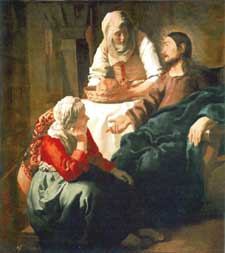 Mary and Martha lived with their brother Lazarus at Bethany, a village not far from Jerusalem. They are mentioned in several episodes in the Gospels.
Mary and Martha lived with their brother Lazarus at Bethany, a village not far from Jerusalem. They are mentioned in several episodes in the Gospels.On one occasion, when Jesus and His disciples were their guests (Luke 10:38-42), Mary sat at Jesus' feet and listened to Him while her sister Martha busied herself with preparing food and waiting on the guests, and when Martha complained, Jesus said that Mary had chosen the better part.
When Lazarus, the brother of Mary and Martha, had died, Jesus came to Bethany. Martha, upon being told that He was approaching, went out to meet Him, while Mary sat still in the house until He sent for her. It was to Martha that Jesus said: "I am the Resurrection and the Life." (John 11:1-44)
Again, about a week before the crucifixion, as Jesus reclined at table, Mary poured a flask of expensive perfume over Jesus' feet. Mary was criticized for wasting what might have been sold to raise money for the poor, and again Jesus spoke on her behalf. (John 12:1-8)
On the basis of these incidents, many Christian writers have seen Mary as representing Contemplation (prayer and devotion), and Martha as representing Action (good works, helping others); or love of God and love of neighbor respectively.
They see the same symbolism also in Leah and Rachel, the daughters of Laban (Genesis 29 and 35). Leah was dim of sight, but had many children. Rachel had few children, but one of them saved the whole family from destruction. Leah represents Action, which is near-sighted and cannot penetrate very far into the mysteries of God, but produces many worth-while results. Contemplation has fewer results, but one of those results is Faith, without which it is impossible to please God." (Hebrews 11:6) Yet, there is a sense in which Action comes first -- "If a man love not his brother, whom he hath seen, how shall he love God, whom he hath not seen?" (1 John 4:20) So it is that Leah must be wed before Rachel.
WILLLIAM WILBERFORCE
RENEWER OF SOCIETY (30 JULY 1833)
The motion was defeated. Wilberforce brought it up again every year for eighteen years, until the slave trade was finally abolished on 25 March 1806. He continued the campaign against slavery itself, and the bill for the abolition of all slavery in British territories passed its crucial vote just four days before his death on 29 July 1833. A year later, on 31 July 1834, 800,000 slaves, chiefly in the British West Indies, were set free.
IGNATIUS LOYOLA
MYSTIC, EDUCATOR, PREACHER, AND FOUNDER OF THE JESUITS (31 JULY 1556)
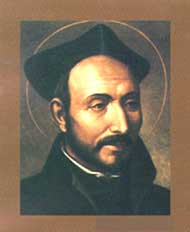 Iñigo de Recalde de Loyola, youngest of thirteen (one of my sources says eleven) children of Don Beltran Ya'ñez de Loyola and Maria Sa'enz de Licona y Balda, was born in 1491 in the family castle in the Basque province of Gu'ipozcoa, in northeastern Spain, near the French border. As befitted a boy from an aristocratic family, he spent some time as a page at the court of Ferdinand and Isabella, the rulers of Spain. Here, by his later testimony, he was involved in gambling, wenching, and duelling. He got into trouble with the law, but escaped punishment because he was technically a cleric. (This does not mean that he was destined for the priesthood. In those days someone becoming a priest went through seven steps: doorkeeper, reader, exorcist, acolyte, subdeacon, deacon, and priest. The first four were called Minor Orders, and did not involve any serious commitment, but they did make one technically a cleric, which was useful if one got arrested for anything less than murder or treason. Probably many young noblemen took the first step simply as a precaution. Later the law extended the definition of "cleric" to anyone who could read. See the BIO notes on Thomas a Becket, 29 December.) He then entered military service, but fought in only one major battle, the defense of Pamplona against the French in 1521. The professional solders knew that their position was indefensible, and proposed to surrender. Iñigo (or Ignatius, to give him the Latin form of his name) had visions of military glory, and urged his comrades to fight. He was promptly hit in the leg by a cannon ball, the town surrendered anyway, and the French sent him home on a stretcher.
Iñigo de Recalde de Loyola, youngest of thirteen (one of my sources says eleven) children of Don Beltran Ya'ñez de Loyola and Maria Sa'enz de Licona y Balda, was born in 1491 in the family castle in the Basque province of Gu'ipozcoa, in northeastern Spain, near the French border. As befitted a boy from an aristocratic family, he spent some time as a page at the court of Ferdinand and Isabella, the rulers of Spain. Here, by his later testimony, he was involved in gambling, wenching, and duelling. He got into trouble with the law, but escaped punishment because he was technically a cleric. (This does not mean that he was destined for the priesthood. In those days someone becoming a priest went through seven steps: doorkeeper, reader, exorcist, acolyte, subdeacon, deacon, and priest. The first four were called Minor Orders, and did not involve any serious commitment, but they did make one technically a cleric, which was useful if one got arrested for anything less than murder or treason. Probably many young noblemen took the first step simply as a precaution. Later the law extended the definition of "cleric" to anyone who could read. See the BIO notes on Thomas a Becket, 29 December.) He then entered military service, but fought in only one major battle, the defense of Pamplona against the French in 1521. The professional solders knew that their position was indefensible, and proposed to surrender. Iñigo (or Ignatius, to give him the Latin form of his name) had visions of military glory, and urged his comrades to fight. He was promptly hit in the leg by a cannon ball, the town surrendered anyway, and the French sent him home on a stretcher. The leg was badly set, and did not heal properly. It had to be rebroken and reset, and again it healed crookedly and let him with a permanent limp. Meanwhile, he was bedridden for many months, and spent the time reading. He asked for tales of knightly adventure, but instead was given a Life of Christ, written by a Carthusian monk. He read it, and his life was transformed. He went on pilgrimage to Montserrat (near Barcelona), where he hung up his sword over the altar, and then spent about a year at Manresa near Montserrat first working as a nurse and orderly in a hospital there, and then retiring to a cave to live as a hermit and study The Imitation of Christ, by Thomas a Kempis, a book urging the Christian to take Christ as example, and seek daily to follow in His footsteps. It is probably during this year that he wrote his Spiritual Exercises, a manual of Christian prayer and meditation. He directs the reader to begin with an event in the life of Christ, and to imagine the scene in detail, to replay the episode in his mind like a movie script, and to try to feel as if he had himself witnessed the event, and then to use this experience as a motive for love, gratitude, and dedication to the service of God. The book is available today in hardcover and paperback. It has been much used by Christians of all varieties--John Wesley was enthusiastic about it. Ignatius then made a pilgrimage to Jerusalem to see with his own eyes the scenes of Our Lord's life and death. He wanted to stay and preach to the muslims, but the Franciscans stationed there advised him that he needed an education in order to preach effectively.
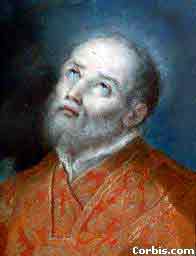 Back in Spain, he spent ten years (1524-1534) getting an education at Barcelona, Alcala', Salamanca, and Paris, beginning by going to elementary school to learn Latin grammar, and ending with a Master of Arts degree from the University of Paris. In Salamanca, he often preached to groups of people assembled by chance; but in those days a layman undertaking to preach on his own, without a license or supervision, was automatically suspected of heresy. Ignatius was twice imprisoned by the Spanish Inquisition and questioned about his beliefs, an experience that made a deep impression on him. (He was finally acquitted, but forbidden to discuss religious matters for three years.) Today, his followers are aggressively proud of the fact that no member of their order has ever sat on an Inquisitorial tribunal. (It is possible that Ignatius already had doubts about the Inquisition. He was a Basque, and I am told that the Inquisition was never active in Biscay because the Basques, although thoroughly orthodox Christians, would not tolerate it.) In 1534, he and six fellow students formed a group who vowed to travel to Jerusalem and there preach the Gospel to the moslems. (The most famous of the six is Francis Xavier, who went to India and China as a missionary, and who is commemorated on 3 December.) This group later took the name, "The Society of Jesus," and were nicknamed "the Jesuits" by outsiders, a nickname that stuck.
Back in Spain, he spent ten years (1524-1534) getting an education at Barcelona, Alcala', Salamanca, and Paris, beginning by going to elementary school to learn Latin grammar, and ending with a Master of Arts degree from the University of Paris. In Salamanca, he often preached to groups of people assembled by chance; but in those days a layman undertaking to preach on his own, without a license or supervision, was automatically suspected of heresy. Ignatius was twice imprisoned by the Spanish Inquisition and questioned about his beliefs, an experience that made a deep impression on him. (He was finally acquitted, but forbidden to discuss religious matters for three years.) Today, his followers are aggressively proud of the fact that no member of their order has ever sat on an Inquisitorial tribunal. (It is possible that Ignatius already had doubts about the Inquisition. He was a Basque, and I am told that the Inquisition was never active in Biscay because the Basques, although thoroughly orthodox Christians, would not tolerate it.) In 1534, he and six fellow students formed a group who vowed to travel to Jerusalem and there preach the Gospel to the moslems. (The most famous of the six is Francis Xavier, who went to India and China as a missionary, and who is commemorated on 3 December.) This group later took the name, "The Society of Jesus," and were nicknamed "the Jesuits" by outsiders, a nickname that stuck.
In 1537 the Jesuits (now ten in number) gathered in Venice and (having found that renewed war in Palestine made journeying there impossible) offered their services to Pope Paul III. Ignatius and some of the others were ordained to the priesthood, and they were assigned various tasks. In 1540 they became a formal organization, with the usual monastic vows, plus a fourth vow of personal obedience to the Pope. In order to have more time for preaching and study the order abolished the practice (followed by almost all previous orders) of reciting the monastic Hours in community. Its chief goals were:
(a) renewal of the Roman Catholic Church through extensive education and the encouragement of frequent use of the sacraments,
(b) extensive missionary work in non-Christian countries, and
(c) a suitable response to the growing challenge of Protestantism.
In the remaining fifteen years of his life, Ignatius supervised the Jesuits from Rome and saw the order grow from ten men to a thousand. It was always active in missions, and became deeply involved in education, and in counselling those with difficult decisions to make, particularly rulers. The Order undertook to win back to the Roman obedience those areas that had recently become Protestant. Ignatius counselled his Jesuits (technically neither monks nor friars, but priests regular) to proceed with charity and moderation, "without hard words or contempt for people's errors." He died suddenly on 31 July 1556. His writing include the following prayer:
Teach us, good Lord, to serve thee as thou deservest;
to give, and not to count the cost,
to fight, and not to heed the wounds,
to toil, and not to seek for rest,
to labor, and not to ask for any reward,
save that of knowing that we do thy will.
JOSEPH OF ARIMATHAEA
[Note: the feast day for Joseph of Arimathaea traditionally falls on 31 July, but has been transferred to 1 August to make room for Ignatius of Loyola]
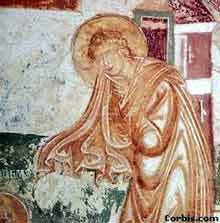 The Gospels tell us (M 27:57-61; P 15:42-47; L 23:50-56; J 19:38-42) that after the death of Jesus, Joseph of Arimathaea, wealthy, a member of the Council, asked Pilate for the body of Jesus, and buried it with honor in the tomb he had intended for himself. This is our only information about him from writers of his own century.
The Gospels tell us (M 27:57-61; P 15:42-47; L 23:50-56; J 19:38-42) that after the death of Jesus, Joseph of Arimathaea, wealthy, a member of the Council, asked Pilate for the body of Jesus, and buried it with honor in the tomb he had intended for himself. This is our only information about him from writers of his own century.
Later tradition has embellished this account. (If not interested in folklore, skip to the closing prayer.) It is said that Joseph was a distant relative of the family of Jesus; that he derived his wealth from tin mines in Cornwall, which he visited from time to time; and that Jesus as a teen-ager accompanied Joseph on one such visit. This is the background of the poem "Jerusalem," by William Blake, which begins:
And did those feet in ancient time
Walk upon England's mountains green?
And was the holy Lamb of God
On England's pleasant pastures seen?
And did the countenance divine
Shine forth upon our clouded hills?
And was Jerusalem builded here
Among those dark satanic mills?
Bring me my bow of burning gold!
Bring me my arrows of desire!
Bring me my spear! O clouds, unfold!
Bring me my chariot of fire!
I will not cease from mental fight,
Nor shall my sword sleep in my hand,
Till we have built Jerusalem
In England's green and pleasant land.
-- William Blake (1757-1827)
[Click here for the music.]
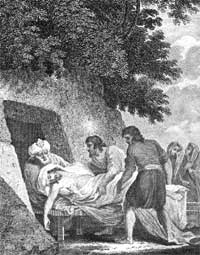 |
| Joseph of Arimathaea with the body of Christ. From an old (1811) Book of Common Prayer. |
Has the Glastonbury legend any basis at all in history? Two facts and some speculations follow:
Tin, an essential ingrediant of bronze, was highly valued in ancient times, and Phoenician ships imported tin from Cornwall. It is a pretty safe guess that in the first century the investors who owned shares in the Cornwall tin trade included at least a few Jewish Christians.
Christianity gained a foothold in Britain very early, probably earlier than in Gaul. It may have been brought there by the traffic of the Cornwall tin trade. If so, then the early British Christians would have a tradition that they had been evangelised by a wealthy Jewish Christian. If they had forgotten his name, it would be natural to consult the Scriptures to see what mention was made of early wealthy Jewish converts. Joseph and Barnabas are almost the only ones named, and much of the life of Barnabas is already accounted for by the book of Acts, which makes him an unsatisfactory candidate. Hence, those who do not like to be vague would say, not, "We were evangelised by some wealthy Jewish Christian whose name we have forgotten," but, "We were evangelised by Joseph of Arimathaea."
Why spend time on any of the above? Because the folk-tales of a community are part of the heritage of a community. Someone wishing to understand the United States will be well advised to familiarize himself with the stories of George Washington's cherry tree and Paul Revere's ride, although he ought not to confuse them with history.
by James Kiefer
For more about Glastonbury and the connection to Joseph of Arimathaea, see: http:britannia.com/history/abbey.html


No comments:
Post a Comment